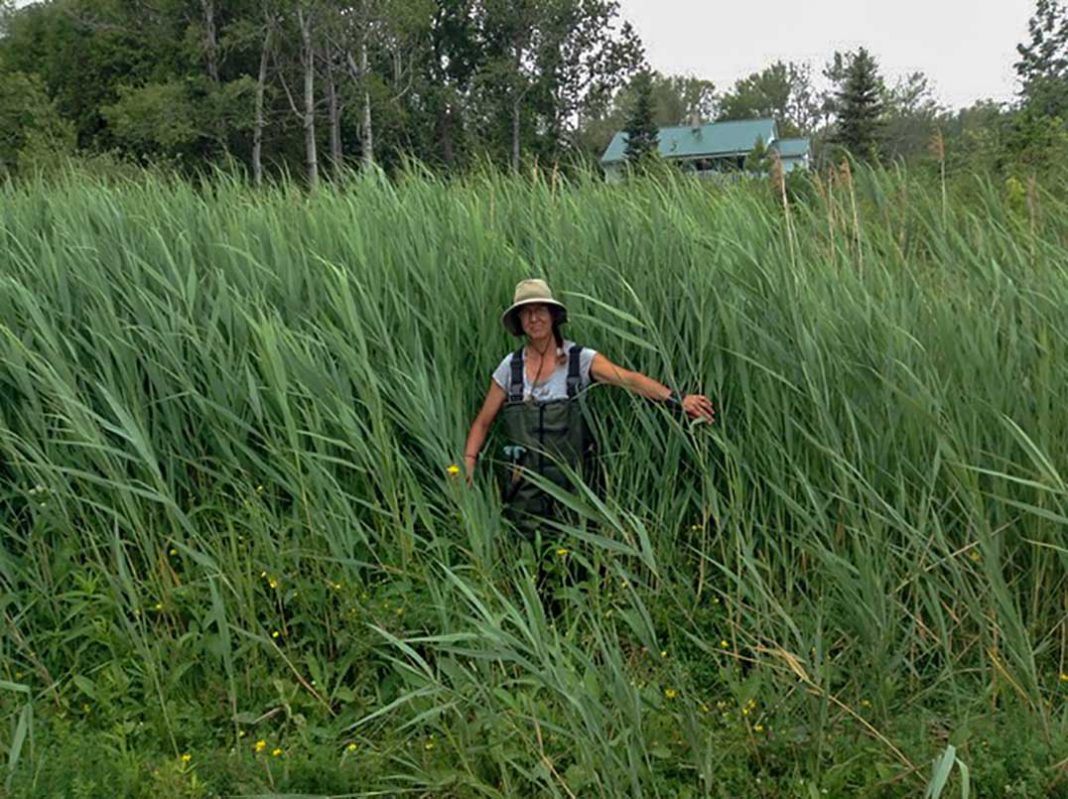MANITOULIN – The battle to defend Manitoulin’s shores from the clogging foreign menace that is phragmites had great success last year and the silver lining of this year’s high water is that a lot of what has been accomplished through the efforts of the past few years are being consolidated—but the battle is far from over and this year’s bywords are vigilance and reporting.
According to project co-ordinator Judith Jones of Winter Spider Eco-Consulting, the Manitoulin Phragmites Project saw its funding cut by half this year and the organization has not heard back on about a third of the funding that is still outstanding, leaving the organization scrambling to make do with private donations. A fundraising campaign is seeing some success and a few more white knights could put those efforts over the top.
“We have just enough to pay our workers,” said Ms. Jones. “We won’t be getting the Truxors this season.” Truxors are massive barge-mounted cutting machines that can manifold expand the effectiveness of the workers, but are expensive. “They are very cost-effective,” she notes, “so when you take that into account they are not at all expensive.” Still, outside the range of this year’s somewhat truncated budget.
“Wiikwemkoong will be bringing in the Truxors for their own shoreline,” noted Ms. Jones.
The project hopes to have the regional phragmites invasion well under control by 2022, but they need the assistance of Island residents to expand their reach.
“We can’t be everywhere and we can’t see everything,” said Ms. Jones. “That is part of what Phrag Week is all about. We want people to check their shorelines and report any stands of phragmites that may be trying to establish a foothold.” That information will prove invaluable to the effort.
Manitoulin Phragmites Project works in partnership with Manitoulin Streams Improvement Association and together with an army of volunteers and paid workers, the project has accomplished incredible strides towards controlling the invasive reed on Manitoulin’s shoreline.
Phragmites stands are incredibly thick banks of reeds that not only drive out native reeds and other plants, but also hinder the reproductive cycles of many endangered species such as turtles trying to make their way ashore to lay eggs and fish seeking spawning grounds.
For example, there were 14 hectares of phragmites in Michael’s Bay last year, this year that patch has been cut back to less than four. The work has been ongoing this year, having begun at the beginning of July. “We are tidying up last year,” said Ms. Jones.
The third week of July has traditionally been the time to spot any phragmites stands. “They have grown up to be bigger and taller than anything else on the shoreline,” she said. “If you are not certain, give us a call and we will come out to whatever place it has been found.”
The objective for 2020 is to establish a steward for each of the stands that have been tackled to date in order to ensure the invasive reed does not re-establish itself.
“We want to make sure that phragmites awareness does not dwindle,” said Ms. Jones. “If people can control it on their own land, we will be closer to our goal of region-wide control by the end of 2022.”
A how-to video has been produced and is available online at YouTube. “The video was made by the folks at Fuel the Fire TV,” Ms. Jones explained, referencing Neil and Diane Debassige’s outdoor sports TV series.
Report phragmites sightings at ManitoulinPhrag@yahoo.com.
The Gosling Foundation has offered to match the first $2,000 in donations raised with an additional $2,000.
Donors who give $25 or more will receive a tax receipt. Money can be sent by electronic mail transfer to streams@amtelecom.net or by cheque or mail (with a note that the money is for the Manitoulin Phragmites Project) to Manitoulin Streams, 25B Spragge St., Box 238, Manitowaning, ON, P0P 1N0.
Together we can send phragmites packing and reclaim our shores.




